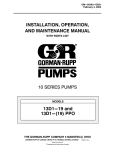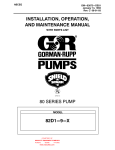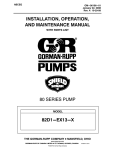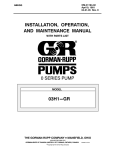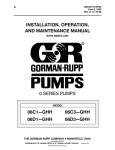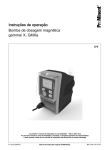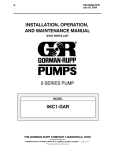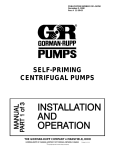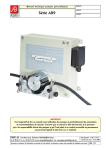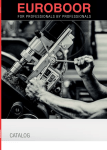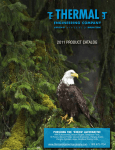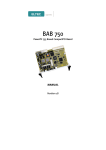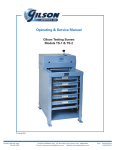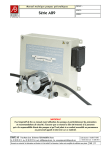Download OM-05465-01
Transcript
ACEGU OM ---05465---OE01 November 13, 2002 INSTALLATION, OPERATION, AND MAINTENANCE MANUAL WITH PARTS LIST 10 SERIES PUMP MODEL 12D1---L48EE THE GORMAN-RUPP COMPANY D MANSFIELD, OHIO GORMAN-RUPP OF CANADA LIMITED D ST. THOMAS, ONTARIO, CANADA www.gormanrupp.com ECopyright by the Gorman-Rupp Company Printed in U.S.A. The engine exhaust from this product contains chemicals known to the State of California to cause cancer, birth defects or other reproductive harm. TABLE OF CONTENTS INTRODUCTION . . . . . . . . . . . . . . . . . . . . . . . . . . . . . . . . . . . . . . . . . . . . . . . . . PAGE I --- 1 SAFETY - SECTION A . . . . . . . . . . . . . . . . . . . . . . . . . . . . . . . . . . . . . . . . . . . . PAGE A --- 1 INSTALLATION --- SECTION B . . . . . . . . . . . . . . . . . . . . . . . . . . . . . . . . . . . . PAGE B --- 1 Pump Dimensions . . . . . . . . . . . . . . . . . . . . . . . . . . . . . . . . . . . . . . . . . . . . . . . . . . . . . PREINSTALLATION INSPECTION . . . . . . . . . . . . . . . . . . . . . . . . . . . . . . . . . . . . . . . . . . . . POSITIONING PUMP . . . . . . . . . . . . . . . . . . . . . . . . . . . . . . . . . . . . . . . . . . . . . . . . . . . . . . . Lifting . . . . . . . . . . . . . . . . . . . . . . . . . . . . . . . . . . . . . . . . . . . . . . . . . . . . . . . . . . . . . . . . . Mounting . . . . . . . . . . . . . . . . . . . . . . . . . . . . . . . . . . . . . . . . . . . . . . . . . . . . . . . . . . . . . Clearance . . . . . . . . . . . . . . . . . . . . . . . . . . . . . . . . . . . . . . . . . . . . . . . . . . . . . . . . . . . . . SUCTION AND DISCHARGE PIPING . . . . . . . . . . . . . . . . . . . . . . . . . . . . . . . . . . . . . . . . . Materials . . . . . . . . . . . . . . . . . . . . . . . . . . . . . . . . . . . . . . . . . . . . . . . . . . . . . . . . . . . . . . Line Configuration . . . . . . . . . . . . . . . . . . . . . . . . . . . . . . . . . . . . . . . . . . . . . . . . . . . . . . Connections to Pump . . . . . . . . . . . . . . . . . . . . . . . . . . . . . . . . . . . . . . . . . . . . . . . . . . Gauges . . . . . . . . . . . . . . . . . . . . . . . . . . . . . . . . . . . . . . . . . . . . . . . . . . . . . . . . . . . . . . . SUCTION LINES . . . . . . . . . . . . . . . . . . . . . . . . . . . . . . . . . . . . . . . . . . . . . . . . . . . . . . . . . . . Fittings . . . . . . . . . . . . . . . . . . . . . . . . . . . . . . . . . . . . . . . . . . . . . . . . . . . . . . . . . . . . . . . Strainers . . . . . . . . . . . . . . . . . . . . . . . . . . . . . . . . . . . . . . . . . . . . . . . . . . . . . . . . . . . . . . Sealing . . . . . . . . . . . . . . . . . . . . . . . . . . . . . . . . . . . . . . . . . . . . . . . . . . . . . . . . . . . . . . . Suction Lines In Sumps . . . . . . . . . . . . . . . . . . . . . . . . . . . . . . . . . . . . . . . . . . . . . . . . . Suction Line Positioning . . . . . . . . . . . . . . . . . . . . . . . . . . . . . . . . . . . . . . . . . . . . . . . . DISCHARGE LINES . . . . . . . . . . . . . . . . . . . . . . . . . . . . . . . . . . . . . . . . . . . . . . . . . . . . . . . . Siphoning . . . . . . . . . . . . . . . . . . . . . . . . . . . . . . . . . . . . . . . . . . . . . . . . . . . . . . . . . . . . . Valves . . . . . . . . . . . . . . . . . . . . . . . . . . . . . . . . . . . . . . . . . . . . . . . . . . . . . . . . . . . . . . . . Bypass Lines . . . . . . . . . . . . . . . . . . . . . . . . . . . . . . . . . . . . . . . . . . . . . . . . . . . . . . . . . . OPERATION --- SECTION C . . . . . . . . . . . . . . . . . . . . . . . . . . . . . . . . . . . . . . PRIMING . . . . . . . . . . . . . . . . . . . . . . . . . . . . . . . . . . . . . . . . . . . . . . . . . . . . . . . . . . . . . . . . . STARTING . . . . . . . . . . . . . . . . . . . . . . . . . . . . . . . . . . . . . . . . . . . . . . . . . . . . . . . . . . . . . . . . OPERATION . . . . . . . . . . . . . . . . . . . . . . . . . . . . . . . . . . . . . . . . . . . . . . . . . . . . . . . . . . . . . . Lines With a Bypass . . . . . . . . . . . . . . . . . . . . . . . . . . . . . . . . . . . . . . . . . . . . . . . . . . . . Lines Without a Bypass . . . . . . . . . . . . . . . . . . . . . . . . . . . . . . . . . . . . . . . . . . . . . . . . . Leakage . . . . . . . . . . . . . . . . . . . . . . . . . . . . . . . . . . . . . . . . . . . . . . . . . . . . . . . . . . . . . . Liquid Temperature And Overheating . . . . . . . . . . . . . . . . . . . . . . . . . . . . . . . . . . . . . Strainer Check . . . . . . . . . . . . . . . . . . . . . . . . . . . . . . . . . . . . . . . . . . . . . . . . . . . . . . . . . Pump Vacuum Check . . . . . . . . . . . . . . . . . . . . . . . . . . . . . . . . . . . . . . . . . . . . . . . . . . STOPPING . . . . . . . . . . . . . . . . . . . . . . . . . . . . . . . . . . . . . . . . . . . . . . . . . . . . . . . . . . . . . . . . Cold Weather Preservation . . . . . . . . . . . . . . . . . . . . . . . . . . . . . . . . . . . . . . . . . . . . . . TROUBLESHOOTING --- SECTION D . . . . . . . . . . . . . . . . . . . . . . . . . . . . . . PREVENTIVE MAINTENANCE . . . . . . . . . . . . . . . . . . . . . . . . . . . . . . . . . . . . . . . . . . . . . . . PUMP MAINTENANCE AND REPAIR - SECTION E . . . . . . . . . . . . . . . . . STANDARD PERFORMANCE CURVE . . . . . . . . . . . . . . . . . . . . . . . . . . . . . . . . . . . . . . . . PARTS LISTS: Pump Model . . . . . . . . . . . . . . . . . . . . . . . . . . . . . . . . . . . . . . . . . . . . . . . . . . . . . . . . . . i PAGE B PAGE B PAGE B PAGE B PAGE B PAGE B PAGE B PAGE B PAGE B PAGE B PAGE B PAGE B PAGE B PAGE B PAGE B PAGE B PAGE B PAGE B PAGE B PAGE B PAGE B ------------------------------------------- 1 1 2 2 2 2 2 2 2 3 3 3 3 3 3 3 4 4 4 4 5 PAGE C --- 1 PAGE C PAGE C PAGE C PAGE C PAGE C PAGE C PAGE C PAGE C PAGE C PAGE C PAGE C ----------------------- 1 1 1 1 2 2 2 2 2 2 3 PAGE D --- 1 PAGE D --- 3 PAGE E --- 1 PAGE E --- 1 PAGE E --- 3 TABLE OF CONTENTS (continued) Pump End Assy . . . . . . . . . . . . . . . . . . . . . . . . . . . . . . . . . . . . . . . . . . . . . . . . . . . . . . . . PUMP AND SEAL DISASSEMBLY AND REASSEMBLY . . . . . . . . . . . . . . . . . . . . . . . . . Suction Check Valve Disassembly . . . . . . . . . . . . . . . . . . . . . . . . . . . . . . . . . . . . . . . . Back Cover Removal . . . . . . . . . . . . . . . . . . . . . . . . . . . . . . . . . . . . . . . . . . . . . . . . . . . Pump Casing Removal . . . . . . . . . . . . . . . . . . . . . . . . . . . . . . . . . . . . . . . . . . . . . . . . . Impeller Removal . . . . . . . . . . . . . . . . . . . . . . . . . . . . . . . . . . . . . . . . . . . . . . . . . . . . . . Seal Removal and Disassembly . . . . . . . . . . . . . . . . . . . . . . . . . . . . . . . . . . . . . . . . . . Seal Reassembly and Installation . . . . . . . . . . . . . . . . . . . . . . . . . . . . . . . . . . . . . . . . Impeller Installation And Adjustment . . . . . . . . . . . . . . . . . . . . . . . . . . . . . . . . . . . . . . Pump Casing Installation . . . . . . . . . . . . . . . . . . . . . . . . . . . . . . . . . . . . . . . . . . . . . . . . Back Cover Installation . . . . . . . . . . . . . . . . . . . . . . . . . . . . . . . . . . . . . . . . . . . . . . . . . Suction Check Valve Installation . . . . . . . . . . . . . . . . . . . . . . . . . . . . . . . . . . . . . . . . . Final Pump Assembly . . . . . . . . . . . . . . . . . . . . . . . . . . . . . . . . . . . . . . . . . . . . . . . . . . LUBRICATION . . . . . . . . . . . . . . . . . . . . . . . . . . . . . . . . . . . . . . . . . . . . . . . . . . . . . . . . . . . . . Seal Assembly . . . . . . . . . . . . . . . . . . . . . . . . . . . . . . . . . . . . . . . . . . . . . . . . . . . . . . . . . Engine . . . . . . . . . . . . . . . . . . . . . . . . . . . . . . . . . . . . . . . . . . . . . . . . . . . . . . . . . . . . . . . . ii PAGE E PAGE E PAGE E PAGE E PAGE E PAGE E PAGE E PAGE E PAGE E PAGE E PAGE E PAGE E PAGE E PAGE E PAGE E PAGE E --------------------------------- 5 6 6 6 6 7 7 7 8 9 9 9 9 9 9 9 10 SERIES OM -- 05465 INTRODUCTION Thank You for purchasing a Gorman-Rupp pump. Read this manual carefully to learn how to safely install and operate your pump. Failure to do so could result in personal injury or damage to the pump. sure that only safe, established maintenance procedures are used, and that any procedures not addressed in this manual are performed only after establishing that neither personal safety nor pump integrity are compromised by such practices. This Installation, Operation, and Maintenance manual is designed to help you achieve the best performance and longest life from your GormanRupp pump. The following are used to alert maintenance personnel to procedures which require special attention, to those which could damage equipment, and to those which could be dangerous to personnel: This pump is a 10 Series, semi-open impeller, selfpriming centrifugal model with a suction check valve. It is close-coupled to a four cycle, air cooled Yanmar diesel engine, model L48EE-DP. The pump is designed for handling most non-volatile, nonflammable liquids containing specified entrained solids. The basic material of construction for wetted parts is gray iron with ductile iron impeller and steel wearing parts. Immediate hazards which WILL result in severe personal injury or death. These instructions describe the procedure required and the injury which will result from failure to follow the procedure. If there are any questions regarding the pump or its application which are not covered in this manual or in other literature accompanying this unit, please contact your Gorman-Rupp distributor, or write: The Gorman-Rupp Company P.O. Box 1217 Mansfield, Ohio 44901-- 1217 Phone: (419) 755-- 1011 or: Gorman-Rupp of Canada Limited 70 Burwell Road St. Thomas, Ontario N5P 3R7 Phone: (519) 631-- 2870 As described on the following page, this manual will alert personnel to known procedures which require special attention, to those which could damage equipment, and to those which could be dangerous to personnel. However, this manual cannot possibly anticipate and provide detailed precautions for every situation that might occur during maintenance of the unit. Therefore, it is the responsibility of the owner/maintenance personnel to enINTRODUCTION Hazards or unsafe practices which COULD result in severe personal injury or death. These instructions describe the procedure required and the injury which could result from failure to follow the procedure. Hazards or unsafe practices which COULD result in minor personal injury or product or property damage. These instructions describe the requirements and the possible damage which could result from failure to follow the procedure. NOTE Instructions to aid in installation, operation, and maintenance or which clarify a procedure. PAGE I -- 1 10 SERIES OM -- 05465 SAFETY - SECTION A This information applies to 10 Series engine driven pumps. Refer to the manual accompanying the engine before attempting to begin operation. This manual will alert personnel to known procedures which require special attention, to those which could damage equipment, and to those which could be dangerous to personnel. However, this manual cannot possibly provide detailed instructions and precautions for each specific application or for every situation that might occur during maintenance of the unit. Therefore, it is the responsibility of the owner, installer and/or maintenance personnel to ensure that applications and/or maintenance procedures not addressed in this manual are performed only after establishing that neither personal safety nor pump integrity are compromised by such applications or procedures. Before attempting to open or service the pump: 1. Familiarize yourself with this manual. 2. Shut down the engine and take precautions to ensure that the pump will remain inoperative. 3. Allow the pump to completely cool if overheated. 4. Check the temperature before opening any covers, plates, or plugs. 5. Close the suction and discharge valves. 6. Vent the pump slowly and cautiously. 7. Drain the pump. SAFETY This pump is designed to handle most non-volatile, non-flammable liquids containing specified entrained solids. Do not attempt to pump volatile, corrosive, or flammable liquids which may damage the pump or endanger personnel as a result of pump failure. Use lifting and moving equipment in good repair and with adequate capacity to prevent injuries to personnel or damage to equipment. Suction and discharge hoses and piping must be removed from the pump before lifting. After the pump has been installed, make certain that the pump and all piping or hose connections are tight, properly supported and secure before operation. Do not operate the pump against a closed discharge valve for long periods of time. If operated against a closed discharge valve, pump components will deteriorate, and the liquid could come to a boil, build pressure, and cause the pump casing to rupture or explode. Overheated pumps can cause severe burns and injuries. If overheating of the pump occurs: 1. Stop the pump immediately. PAGE A -- 1 OM -- 05465 2. Ventilate the area. 3. Allow the pump completely to cool. 4. Check the temperature before opening any covers, plates, gauges, or plugs. 5. Vent the pump slowly and cautiously. 6. Refer to instructions in this manual before restarting the pump. Do not remove plates, covers, gauges, pipe plugs, or fittings from an overheated pump. Vapor pressure within the pump can cause parts being disengaged to be ejected with great force. Allow the pump to cool before servicing. 10 SERIES Fuel used by internal combustion engines presents an extreme explosion and fire hazard. Make certain that all fuel lines are securely connected and free of leaks. Never refuel a hot or running engine. Avoid overfilling the fuel tank. Always use the correct type of fuel. Never tamper with the governor to gain more power. The governor establishes safe operating limits that should not be exceeded. The maximum continuous operating speed for this pump is 3600 RPM. Do not operate an internal combustion engine in an explosive atmosphere. When operating internal combustion engines in an enclosed area, make certain that exhaust fumes are piped to the outside. These fumes contain carbon monoxide, a deadly gas that is colorless, tasteless, and odorless. PAGE A -- 2 SAFETY 10 SERIES OM -- 05465 INSTALLATION --- SECTION B Review all SAFETY information in Section A. Since pump installations are seldom identical, this section offers only general recommendations and practices required to inspect, position, and arrange the pump and piping. specific application. Since the pressure supplied to the pump is critical to performance and safety, be sure to limit the incoming pressure to 50% of the maximum permissible operating pressure as shown on the pump performance curve (see Section E, Page 1). Most of the information pertains to a standard static lift application where the pump is positioned above the free level of liquid to be pumped. For further assistance, contact your Gorman-Rupp distributor or the Gorman-Rupp Company. If installed in a flooded suction application where the liquid is supplied to the pump under pressure, some of the information such as mounting, line configuration, and priming must be tailored to the Pump Dimensions See Figure 1 for the approximate physical dimensions of this pump. OUTLINE DRAWING Figure 1. Pump Model 12D1-L48EE PREINSTALLATION INSPECTION The pump assembly was inspected and tested before shipment from the factory. Before installation, inspect the pump for damage which may have occurred during shipment. Check as follows: INSTALLATION a. Inspect the pump and engine for cracks, dents, damaged threads, and other obvious damage. b. Check for and tighten loose attaching hardware. Since gaskets tend to shrink after dryPAGE B -- 1 OM -- 05465 ing, check for loose hardware at mating surfaces. c. Carefully read all tags, decals, and markings on the pump assembly, and perform all duties indicated. d. Check levels and lubricate as necessary. Refer to LUBRICATION in the MAINTENANCE AND REPAIR section of this manual and perform duties as instructed. e. If the pump and engine have been stored for more than 12 months, some of the components or lubricants may have exceeded their maximum shelf life. These must be inspected or replaced to ensure maximum pump service. f. The rubber mounting kit and discharge elbow (see the Parts List, pages E-3 and E-5) were shipped loose with the pump. Refer to Figure 1, page E-2 and install the parts as shown. If the maximum shelf life has been exceeded, or if anything appears to be abnormal, contact your Gorman-Rupp distributor or the factory to determine the repair or updating policy. Do not put the pump into service until appropriate action has been taken. POSITIONING PUMP Lifting This pump is designed to be lightweight and portable. The pump is protected by the wrap-around roll cage, which also serves as a two-man carry handle. The total pump weight is approximately 108 pounds (49 kg), not including accessories or engine fuel. Customer installed equipment such as suction hose with foot valve must be removed before attempting to lift. Mounting Locate the pump in an accessible place as close as practical to the liquid being pumped. Level mounting is essential for proper operation. PAGE B -- 2 10 SERIES The pump may have to be supported or shimmed to provide for level operation or to eliminate vibration. If the pump has been mounted on a moveable base, make certain the base is stationary by setting the brake and blocking the wheels before attempting to operate the pump. To ensure sufficient lubrication and fuel supply to the engine, do not position the pump and engine more than 15_ off horizontal for continuous operation. The pump and engine may be positioned up to 30_ off horizontal for intermittent operation only; however, the engine manufacturer should be consulted for continuous operation at angles greater than 15_. Clearance When positioning the pump, allow a minimum clearance of 18 inches (457,2 mm) in front of the back cover to permit removal of the cover and easy access to the pump interior. SUCTION AND DISCHARGE PIPING Pump performance is adversely effected by increased suction lift, discharge elevation, and friction losses. See the performance curve and notes on Page E-1 to be sure your overall application allows pump to operate within the safe operation range. Materials Either pipe or hose maybe used for suction and discharge lines; however, the materials must be compatible with the liquid being pumped. If hose is used in suction lines, it must be the rigid-wall, reinforced type to prevent collapse under suction. Using piping couplings in suction lines is not recommended. Line Configuration Keep suction and discharge lines as straight as possible to minimize friction losses. Make minimum use of elbows and fittings, which substantially increase friction loss. If elbows are necessary, use the long-radius type to minimize friction loss. INSTALLATION 10 SERIES OM -- 05465 Connections to Pump Strainers Before tightening a connecting flange, align it exactly with the pump port. Never pull a pipe line into place by tightening the flange bolts and/or couplings. If a strainer is furnished with the pump, be certain to use it; any spherical solids which pass through a strainer furnished with the pump will also pass through the pump itself. Lines near the pump must be independently supported to avoid strain on the pump which could cause excessive vibration, decreased bearing life, and increased shaft and seal wear. If hose-type lines are used, they should have adequate support to secure them when filled with liquid and under pressure. Gauges Most pumps are drilled and tapped for installing discharge pressure and vacuum suction gauges. If these gauges are desired for pumps that are not tapped, drill and tap the suction and discharge lines not less than 18 inches (457,2 mm) from the suction and discharge ports and install the lines. Installation closer to the pump may result in erratic readings. SUCTION LINES To avoid air pockets which could affect pump priming, the suction line must be as short and direct as possible. When operation involves a suction lift, the line must always slope upward to the pump from the source of the liquid being pumped; if the line slopes down to the pump at any point along the suction run, air pockets will be created. The maximum vertical suction lift for this pump is 25 ft. (7,6 m). It is not designed to be operated at a higher lift. Fittings Suction lines should be the same size as the pump inlet. If reducers are used in suction lines, they should be the eccentric type, and should be installed with the flat part of the reducers uppermost to avoid creating air pockets. Valves are not normally used in suction lines, but if a valve is used, install it with the stem horizontal to avoid air pockets. INSTALLATION If a strainer is not furnished with the pump, but is installed by the pump user, make certain that the total area of the openings in the strainer is at least three or four times the cross section of the suction line, and that the openings will not permit passage of solids larger than the solids handling capability of the pump. This pump is designed to handle up to 1-3/16 inch (30 mm) diameter spherical solids. Sealing Since even a slight leak will affect priming, head, and capacity, especially when operating with a high suction lift, all connections in the suction line should be sealed with pipe dope to ensure an airtight seal. Follow the sealant manufacturer’s recommendations when selecting and applying the pipe dope. The pipe dope should be compatible with the liquid being pumped. Suction Lines In Sumps If a single suction line is installed in a sump, it should be positioned away from the wall of the sump at a distance equal to 1-1/2 times the diameter of the suction line. If there is a liquid flow from an open pipe into the sump, the flow should be kept away from the suction inlet because the inflow will carry air down into the sump, and air entering the suction line will reduce pump efficiency. If it is necessary to position inflow close to the suction inlet, install a baffle between the inflow and the suction inlet at a distance 1-1/2 times the diameter of the suction pipe. The baffle will allow entrained air to escape from the liquid before it is drawn into the suction inlet. If two suction lines are installed in a single sump, the flow paths may interact, reducing the efficiency of one or both pumps. To avoid this, position the suction inlets so that they are separated by a disPAGE B -- 3 OM -- 05465 tance equal to at least 3 times the diameter of the suction pipe. Suction Line Positioning The depth of submergence of the suction line is critical to efficient pump operation. Figure 2 shows recommended minimum submergence vs. velocity. 10 SERIES NOTE The pipe submergence required may be reduced by installing a standard pipe increaser fitting at the end of the suction line. The larger opening size will reduce the inlet velocity. Calculate the required submergence using the following formula based on the increased opening size (area or diameter). Figure 2. Recommended Minimum Suction Line Submergence vs. Velocity DISCHARGE LINES Siphoning A check valve in the discharge line is normally recommended, but it is not necessary in low discharge head applications. Do not terminate the discharge line at a level lower than that of the liquid being pumped unless a siphon breaker is used in the line. Otherwise, a siphoning action causing damage to the pump could result. With high discharge heads, it is recommended that a throttling valve and a system check valve be installed in the discharge line to protect the pump from excessive shock pressure and reverse rotation when it is stopped. Valves If a throttling valve is desired in the discharge line, use a valve as large as the largest pipe to minimize friction losses. Never install a throttling valve in a suction line. PAGE B -- 4 If the application involves a high discharge head, gradually close the discharge throttling valve before stopping the pump. INSTALLATION 10 SERIES Bypass Lines If a system check valve is used due to high discharge head, it may be necessary to vent trapped air from the top of the pump during the priming process. This may be accomplished by installing a INSTALLATION OM -- 05465 bypass line from the top of the pump, back to the source of liquid. The end of the bypass line must be submerged. The line must be large enough to prevent clogging, but not so large as to affect pump discharge capacity. PAGE B -- 5 OM -- 05465 10 SERIES OPERATION --- SECTION C Review all SAFETY information in Section A. Follow the instructions on all tags, labels and decals attached to the pump. This pump is designed to pump most non-volatile, non-flammable liquids containing specified entrained solids. Do not attempt to pump volatile, corrosive, or flammable liquids which may damage the pump or endanger personnel as a result of pump failure. Never tamper with the governor to gain more power. The governor establishes safe operating limits that should not be exceeded. The maximum continuous operating speed for this pump is 3600 RPM. PRIMING Install the pump and piping as described in INSTALLATION. Make sure that the piping connections are tight, and that the pump is securely mounted. Check that the pump is properly lubricated (see LUBRICATION in MAINTENANCE AND REPAIR). This pump is self-priming, but the pump should never be operated unless there is liquid in the pump casing. Never operate this pump unless there is liquid in the pump casing. The pump will OPERATION not prime when dry. Extended operation of a dry pump will destroy the seal assembly. Add liquid to the pump casing when: 1. The pump is being put into service for the first time. 2. The pump has not been used for a considerable length of time. 3. The liquid in the pump casing has evaporated. Once the pump casing has been filled, the pump will prime and reprime as necessary. After filling the pump casing, reinstall and tighten the fill plug. Do not attempt to operate the pump unless all connecting piping is securely installed. Otherwise, liquid in the pump forced out under pressure could cause injury to personnel. To fill the pump, remove the pump casing fill cover or fill plug in the top of the casing, and add clean liquid until the casing is filled. Replace the fill cover or fill plug before operating the pump. STARTING Consult the operations manual furnished with the engine. OPERATION Lines With a Bypass Close the discharge throttling valve (if so equipped) so that the pump will not have to prime against the weight of the liquid in the discharge line. Air from the suction line will be discharged through the bypass line back to the wet well during the priming cycle. When the pump is fully primed and liquid is flowing steadily from the bypass line, PAGE C -- 1 OM -- 05465 open the discharge throttling valve. Liquid will then continue to circulate through the bypass line while the pump is in operation. Lines Without a Bypass Open all valves in the discharge line and start the engine. Priming is indicated by a positive reading on the discharge pressure gauge or by a quieter operation. The pump may not prime immediately because the suction line must first fill with liquid. If the pump fails to prime within five minutes, stop it and check the suction line for leaks. After the pump has been primed, partially close the discharge line throttling valve in order to fill the line slowly and guard against excessive shock pressure which could damage pipe ends, gaskets, sprinkler heads, and any other fixtures connected to the line. When the discharge line is completely filled, adjust the throttling valve to the required flow rate. Leakage No leakage should be visible at pump mating surfaces, or at pump connections or fittings. Keep all line connections and fittings tight to maintain maximum pump efficiency. Liquid Temperature And Overheating The maximum liquid temperature for this pump is 110_ F (43_C). Do not apply it at a higher operating temperature. Overheating can occur if operated with the valves in the suction or discharge lines closed. Operating against closed valves could bring the liquid to a boil, build pressure, and cause the pump to rupture or explode. If overheating occurs, stop the pump and allow it to cool before servicing it. Refill the pump casing with cool liquid. Do not remove plates, covers, gauges, pipe plugs, or fittings from an overheated pump. Vapor pressure within the pump can cause parts being disenPAGE C -- 2 10 SERIES gaged to be ejected with great force. Allow the pump to cool before servicing. Strainer Check If a suction strainer has been shipped with the pump or installed by the user, check the strainer regularly, and clean it as necessary. The strainer should also be checked if pump flow rate begins to drop. If a vacuum suction gauge has been installed, monitor and record the readings regularly to detect strainer blockage. Never introduce air or steam pressure into the pump casing or piping to remove a blockage. This could result in personal injury or damage to the equipment. If backflushing is absolutely necessary, liquid pressure must be limited to 50% of the maximum permissible operating pressure shown on the pump performance curve. (See Section E, Page 1.) Pump Vacuum Check With the pump inoperative, install a vacuum gauge in the system, using pipe dope on the threads. Block the suction line and start the pump. At operating speed the pump should pull a vacuum of 20 inches (508 mm) or more of mercury. If it does not, check for air leaks in the seal, gasket, or discharge valve. Open the suction line, and read the vacuum gauge with the pump primed and at operation speed. Shut off the pump. The vacuum gauge reading will immediately drop proportionate to static suction lift, and should then stabilize. If the vacuum reading falls off rapidly after stabilization, an air leak exists. Before checking for the source of the leak, check the point of installation of the vacuum gauge. STOPPING Never halt the flow of liquid suddenly. If the liquid being pumped is stopped abruptly, damaging shock waves can be transmitted to the pump and piping system. Close all connecting valves slowly. On engine driven pumps, reduce the throttle speed slowly and allow the engine to idle briefly before stopping. OPERATION 10 SERIES If the application involves a high discharge head, gradually close the discharge throttling valve before stopping the pump. After stopping the pump, remove the spark plug wire to ensure that the pump will remain inoperative. Cold Weather Preservation In below freezing conditions, drain the pump to OPERATION OM -- 05465 prevent damage from freezing. Also, clean out any solids by flushing with a hose. Operate the pump for approximately one minute; this will remove any remaining liquid that could freeze the pump rotating parts. If the pump will be idle for more than a few hours, or if it has been pumping liquids containing a large amount of solids, drain the pump, and flush it thoroughly with clean water. To prevent large solids from clogging the drain port and preventing the pump from completely draining, insert a rod or stiff wire in the drain port, and agitate the liquid during the draining process. Clean out any remaining solids by flushing with a hose. PAGE C -- 3 10 SERIES OM -- 05465 TROUBLESHOOTING --- SECTION D Review all SAFETY information in Section A. Before attempting to open or service the pump: 1. Familiarize yourself with this manual. 2. Shut down the engine and disconnect the spark plug wire to ensure that the pump will remain inoperative. 3. Allow the pump to completely cool if overheated. 4. Check the temperature before opening any covers, plates, or plugs. 5. Close the suction and discharge valves. 6. Vent the pump slowly and cautiously. 7. Drain the pump. TROUBLE PUMP FAILS TO PRIME TROUBLESHOOTING POSSIBLE CAUSE PROBABLE REMEDY Not enough liquid in casing. Add liquid to casing. See PRIMING. Suction check valve contaminated or damaged. Clean or replace check valve. Air leak in suction line. Correct leak. Lining of suction hose collapsed. Replace suction hose. Leaking or worn seal or pump gasket. Check pump vacuum. Replace leaking or worn seal or gasket. Suction check valve or foot valve clogged or binding. Clean valve. Suction lift or discharge head too high. Check piping installation and install bypass line if needed. See INSTALLATION. Strainer clogged. Check strainer and clean if necessary. PAGE D -- 1 OM -- 05465 TROUBLE PUMP STOPS OR FAILS TO DELIVER RATED FLOW OR PRESSURE PUMP REQUIRES TOO MUCH POWER PUMP CLOGS FREQUENTLY EXCESSIVE NOISE PAGE D -- 2 10 SERIES POSSIBLE CAUSE PROBABLE REMEDY Air leak in suction line. Correct leak. Suction intake not submerged at proper level or sump too small. Check installation and correct submergence as needed. Lining of suction hose collapsed. Replace suction hose. Impeller or other wearing parts worn or damaged. Replace worn or damaged parts. Check that impeller is properly centered and rotates freely. Impeller clogged. Free impeller of debris. Pump speed too slow. Check engine output; consult engine operation manual. Suction lift or discharge head too high. Check piping installation and install bypass line if needed. See INSTALLATION. Leaking or worn seal or pump gasket. Check pump vacuum. Replace leaking or worn seal or gasket. Strainer clogged. Check strainer and clean if necessary. Pump speed too high. Check engine output. Discharge head too low. Adjust discharge valve. Liquid solution too thick. Dilute if possible. Discharge flow too slow. Open discharge valve fully to increase flow rate, and run engine at maximum governed speed. Suction check valve or foot valve clogged or binding. Clean valve. Discharge line clogged or restricted; hose kinked. Check discharge lines; straighten hose. Cavitation in pump. Reduce suction lift and/or friction losses in suction line. Record vacuum and pressure gauge readings and consult local representative or factory. Pumping entrained air. Locate and eliminate source of air bubble. Pump or drive not securely mounted. Secure mounting hardware. Impeller clogged or damaged. Clean out debris; replace damaged parts. TROUBLESHOOTING 10 SERIES OM -- 05465 PREVENTIVE MAINTENANCE Since pump applications are seldom identical, and pump wear is directly affected by such things as the abrasive qualities, pressure and temperature of the liquid being pumped, this section is intended only to provide general recommendations and practices for preventive maintenance. Regardless of the application however, following a routine preventive maintenance schedule will help assure trouble-free performance and long life from your Gorman-Rupp pump. For specific questions concerning your application, contact your Gorman-Rupp distributor or the Gorman-Rupp Company. Record keeping is an essential component of a good preventive maintenance program. Changes in suction and discharge gauge readings (if so equipped) between regularly scheduled inspections can indicate problems that can be corrected before system damage or catastrophic failure occurs. The appearance of wearing parts should also be documented at each inspection for comparison as well. Also, if records indicate that a certain part (such as the seal) fails at approximately the same duty cycle, the part can be checked and replaced before failure occurs, reducing unscheduled down time. For new applications, a first inspection of wearing parts at 250 hours will give insight into the wear rate for your particular application. Subsequent inspections should be performed at the intervals shown on the chart below. Critical applications should be inspected more frequently. Preventive Maintenance Schedule Item General Condition (Temperature, Unusual Noises or Vibrations, Cracks, Leaks, Loose Hardware, Etc.) Pump Performance (Gauges, Speed, Flow) Bearing Lubrication Seal Lubrication (And Packing Adjustment, If So Equipped) V-Belts (If So Equipped) Air Release Valve Plunger Rod (If So Equipped) Front Impeller Clearance (Wear Plate) Rear Impeller Clearance (Seal Plate) Check Valve Pressure Relief Valve (If So Equipped) Pump and Driver Alignment Shaft Deflection Bearings Bearing Housing Piping Driver Lubrication --- See Mfgr’s Literature Service Interval* Daily I I Weekly Monthly Semi- Annually Annually I I R I I R C I I I C I I I I I Legend: I = Inspect, Clean, Adjust, Repair or Replace as Necessary C = Clean R = Replace * Service interval based on an intermittent duty cycle equal to approximately 4000 hours annually. Adjust schedule as required for lower or higher duty cycles or extreme operating conditions. TROUBLESHOOTING PAGE D -- 3 10 SERIES OM -- 05465 PUMP MAINTENANCE AND REPAIR - SECTION E MAINTENANCE AND REPAIR OF THE WEARING PARTS OF THE PUMP WILL MAINTAIN PEAK OPERATING PERFORMANCE. STANDARD PERFORMANCE FOR PUMP MODEL 12D1-- L48EE Based on 70_ F (21_ C) clear water at sea level with minimum suction lift. Since pump installations are seldom identical, your performance may be different due to such factors as viscosity, specific gravity, elevation, temperature, and impeller trim. If your pump serial number is followed by an “N”, your pump is NOT a standard production model. Contact the Gorman-Rupp Company to verify performance or part numbers. MAINTENANCE & REPAIR Never tamper with the governor to gain more power. The governor establishes safe operating limits that should not be exceeded. The maximum continuous operating speed for this pump is 3600 RPM. PAGE E -- 1 OM -- 05465 10 SERIES SECTION DRAWING Figure 1. Pump Model 12D1-L48EE PAGE E -- 2 MAINTENANCE & REPAIR 10 SERIES OM -- 05465 PARTS LIST Pump Model 12D1-L48EE (From S/N 1255241 up) If your pump serial number is followed by an “N”, your pump is NOT a standard production model. Contact the Gorman-Rupp Company to verify part numbers. ITEM NO. 1 2 3 4 5 6 7 8 9 10 11 12 13 14 15 16 17 18 19 20 [ [ PART NAME PART NUMBER MAT’L CODE PUMP PARTS ONLY PRIMING STICKER DISCHARGE STICKER STREET ELBOW YANMAR L48EE ENGINE WARNING DECAL ROLLOVER BASE HAND CARRY DECAL RUBBER FOOT MOUNTING KIT ---MOUNTING FOOT ---FLANGED HEX NUT ---HEX HD CAPSCREW FLAT WASHER FLANGED HEX NUT HEX HD CAPSCREW SPACER FLAT WASHER HEX HD CAPSCREW FLANGED HEX NUT SUCTION STICKER 12D1---(L48EE) PPO --- --- --6588AH --- --- --6588BJ --- --- --RS32 11999 29239---041 --- --- --2613FE --- --- --41583---316 24150 2613FT --- --- --48152---607 --- --- --24631---401 --- --- --21765---312 --- --- --B0506 15991 KE06 15991 21765---314 --- --- --B0606 15991 31141---029 13000 KE06 15991 B0607 15991 21765---314 --- --- --6588AG --- --- --- 1 1 1 1 1 1 1 2 1 4 4 4 2 2 2 2 2 2 2 1 CAUTION-OIL LABEL 45---011 1 QTY NOT SHOWN: --- --- --- Above Serial Numbers Do Not Apply To Pumps Made In Canada. [ Items shipped loose with the pump. MAINTENANCE & REPAIR PAGE E -- 3 OM -- 05465 10 SERIES SECTION DRAWING Figure 2. 12D1-(L48EE) Pump Parts Only PAGE E -- 4 MAINTENANCE & REPAIR 10 SERIES OM -- 05465 PARTS LIST 12D1-(L48EE) Pump Parts Only ITEM NO. 1 2 3 4 5 6 7 8 9 10 11 12 13 14 15 16 17 18 19 20 21 22 23 24 25 26 27 28 29 30 31 32 33 34 35 36 37 NOT SHOWN: PUMP CASING IMPELLER SEAL ASSY IMP ADJ SHIM SET SPRING RETAINER SHAFT SLEEVE STREET ELBOW INTERMEDIATE HEX HD CAPSCREW LOCKWASHER STUD HEX NUT CASING GASKET SET WEAR PLATE LOCKWASHER HEX NUT CASING DRAIN PLUG BACK COVER PLATE ---WARNING PLATE ---COVER PLATE ---DRIVE SCREW STUD FLAT WASHER WING NUT NAME PLATE DRIVE SCREW COVER PLATE GSKT STUD HEX NUT SUCTION FLANGE CHECK VALVE ASSY ---VALVE WEIGHT ---VALVE WEIGHT ---LOCKWASHER ---RD HD MACH SCREW ---CHECK VALVE FILL PLUG ASSY PART NUMBER 38224---205 38615---066 25285---853 513A 31161---041 31411---267 RS32 6732A 22645---130 21171---510 C0605 1/2 D06 504G 46451---018 J04 D04 P06 42111---919 2613EV NOT AVAILABLE BM#04---03 C0808 KE08 BB08 38818---021 BM#04---03 12369G C0606 D06 38645---024 46413---028 19B 1354 J04 X0403 38671---630 48271---063 MAT’L CODE 13040 11060 --- --- --17090 17000 17020 11999 10010 --- --- ----- --- --15991 15991 18000 24150 15991 15991 15079 --- --- --13990 17000 15991 15991 15991 13990 17000 20000 15991 15991 13040 --- --- --10010 15160 17090 17090 19070 --- --- --- 1 1 1 REF 1 1 1 1 4 4 4 4 1 1 2 2 1 1 1 1 4 2 2 2 1 4 1 2 2 1 1 1 1 1 1 1 1 STRAINER 9026D 24001 1 PART NAME QTY INDICATES PARTS RECOMMENDED FOR STOCK MAINTENANCE & REPAIR PAGE E -- 5 OM -- 05465 PUMP AND SEAL DISASSEMBLY AND REASSEMBLY Review all SAFETY information in Section A. Follow the instructions on all tags, labels and decals attached to the pump. This pump requires little service due to its rugged, minimum-maintenance design. However, if it becomes necessary to inspect or replace the wearing parts, follow these instructions which are keyed to the sectional views (see Figures 1 and 2) and the accompanying parts lists. As described on the following pages, this manual will alert personnel to known procedures which require special attention, to those which could damage equipment, and to those which could be dangerous to personnel. However, this manual cannot possibly anticipate and provide detailed precautions for every situation that might occur during maintenance of the unit. Therefore, it is the responsibility of the owner/maintenance personnel to ensure that only safe, established maintenance procedures are used, and that any procedures not addressed in this manual are performed only after establishing that neither personal safety nor pump integrity are compromised by such practices. Before attempting to service the pump, shut down the engine and take precautions7to ensure that it will remain inoperative. Close all valves in the suction and discharge lines. For engine disassembly and repair, consult the literature supplied with the engine, or contact your local Yanmar engine representative. Before attempting to open or service the pump: 1. Familiarize yourself with this manual. 2. Shut down the engine and take precautions to ensure that the pump will remain inoperative. 3. Allow the pump to completely cool if overheated. PAGE E -- 6 10 SERIES 4. Check the temperature before opening any covers, plates, or plugs. 5. Close the suction and discharge valves. 6. Vent the pump slowly and cautiously. 7. Drain the pump. Suction Check Valve Disassembly (Figure 2) Before attempting to service the pump, remove the pump casing drain plug (19) and drain the pump. Clean and reinstall the drain plug. To service the suction check valve, remove the suction piping. Remove the hex nuts (29) securing the suction flange (30) to the pump casing (1). Pull the check valve assembly (31) from the suction port. Inspect the check valve assembly for wear or damage. Remove the hardware (34 and 35) securing the check valve weights (32 and 33) to the check valve (36). Replace parts as required. If no further disassembly is required, see Suction Check Valve Installation. Back Cover Removal (Figure 2) The wear plate (14) can be serviced after the back cover assembly (18) has been removed. Remove the wing nuts and washers (23 and 24) securing the back cover to the casing. Pull the back cover and assembled wear plate from the pump casing. Inspect the wear plate for excessive wear or scoring. If replacement is required, remove the hardware (15 and 16) securing it to the back cover. Remove the cover plate gasket (27) and clean the mating surfaces. Pump Casing Removal (Figure 1) To service the impeller or seal assembly, disconnect the discharge piping. Remove the hardware MAINTENANCE & REPAIR 10 SERIES (16, 17, 18 and 19) securing the pump casing to the rollover base (7). (Figure 2) Support the pump casing using a suitable hoist and sling. Remove the nuts (12), and separate the pump casing (1) from the intermediate (8) by pulling the casing straight away. For ease of reassembly, tie and tag any leveling shims used under the casing mounting feet. OM -- 05465 Seal Reassembly and Installation (Figures 2 and 3) Inspect the engine crankshaft for damage. Small scratches or nicks may be removed with a fine file or emery cloth. If excessive wear exists, the shaft will have to be replaced in the engine (refer to the engine service manual). Clean the seal cavity and shaft with a cloth soaked in fresh cleaning solvent. Remove the casing gaskets (13). Clean the mating surfaces of the intermediate and pump casing. Impeller Removal (Figure 2) To loosen the impeller (2), tap the vanes of the impeller in a counterclockwise direction (when facing the impeller) with a block of wood or a soft-faced mallet. Be careful not to damage the vane. Unscrew the impeller and replace it if cracked or badly worn. Use caution when removing the impeller; tension on the seal spring will be released as the impeller is unscrewed. Slide the impeller adjusting shims (4) off the impeller shaft. Tie and tag the shims or measure and record their thickness for ease of reassembly. Seal Removal and Disassembly (Figure 2 and 3) Remove the spring retainer (5) and seal spring. Slide shaft sleeve (6) and rotating portion of the seal off the shaft as a unit. Apply oil to the sleeve and work it under the bellows. Slide the rotating portion of the seal off the sleeve. To remove the stationary seat and O-ring, remove the hardware (9 and 10), and slide the stationary portion of the seal and intermediate (8) off the shaft as a unit. Position the intermediate on a flat surface with the impeller side down. Use thumb pressure to press the stationary seat and O-ring from the intermediate. If no further disassembly is required, see Seal Reassembly and Installation. MAINTENANCE & REPAIR Most cleaning solvents are toxic and flammable. Use them only in a well ventilated area free from excessive heat, sparks, and flame. Read and follow all precautions printed on solvent containers. Inspect the engine shaft for damage. Small scratches or nicks may be removed with a fine file or emery cloth. If excessive wear exists, the shaft will have to be replaced (refer to the engine service manual). The seal is not normally reused because wear patterns on the finished faces cannot be realigned during reassembly. This could result in premature failure. If necessary to reuse an old seal in an emergency, carefully wash all metallic parts in fresh cleaning solvent and allow to dry thoroughly. Handle the seal parts with extreme care to prevent damage. Be careful not to contaminate precision finished faces; even fingerprints on the faces can shorten seal life. If necessary, clean the faces with a non-oil based solvent and a clean, lint-free tissue. Wipe lightly in a concentric pattern to avoid scratching the faces. Inspect the seal components for wear, scoring, grooves, and other damage that might cause leakage. Clean and polish the shaft sleeve, or replace it if there are nicks or cuts on either end. If any components are worn, replace the complete seal; never mix old and new seal parts. If a replacement seal is being used, remove it from the container and inspect the precision finished PAGE E -- 7 OM -- 05465 10 SERIES faces to ensure that they are free of any foreign matter. To ease installation of the seal, lubricate the O-ring SPRING and shaft sleeve with water or a very small amount of oil, and apply a drop of light lubricating oil on the finished faces. Assemble the seal as follows, (see Figure 3). RETAINER INTERMEDIATE SPRING RETAINER IMPELLER BELLOWS SHAFT SLEEVE IMPELLER SHAFT IMPELLER SHIMS DRIVE BAND STATIONARY SEAT ROTATING ELEMENT Figure 3. 25285-- 853 Seal Assembly This seal is not designed for operation at temperatures above 160_F (71_C). Do not use at higher operating temperatures. Press the stationary subassembly into the intermediate until fully seated. After installation, wipe the sealing face lightly in a concentric pattern with a clean, lint-free tissue. Position the intermediate (8) and stationary subassembly over the shaft and against the engine. Secure the intermediate to the engine with the hardware (9 and 10). Slide the rotating subassembly (consisting of the element, bellows and retainer) over the lubricated shaft sleeve until the rotating element is just flush with the chamfered end of the sleeve. Slide the PAGE E -- 8 sleeve over the shaft until the sealing faces contact. Continue to press the shaft sleeve through the seal assembly until it seats squarely against the shaft shoulder. Install the seal spring and spring retainer (5). Impeller Installation And Adjustment (Figure 2) Inspect the impeller, and replace it if cracked or badly worn. Install the same thickness of impeller shims (4) as previously removed and screw the impeller onto the shaft until tight. A clearance of .015 to .040 inch (0,38 to 1,02 mm) between the impeller and the intermediate is necessary for maximum pump efficiency. Measure this clearance and add or remove impeller shims until this clearance is reached. MAINTENANCE & REPAIR 10 SERIES OM -- 05465 Pump Casing Installation (Figure 2) Install the same thickness of pump casing gaskets (13) as previously removed and secure the pump casing (1) to the intermediate (8) with the nuts (12). Do not fully tighten the nuts at this time. A clearance of .010 to .020 inch (0,25 to 0,51 mm) between the impeller and the wear plate is also recommended for maximum pump efficiency. This clearance must be set after installing the back cover by adding or removing pump casing gaskets until the impeller scrapes against the wear plate when the shaft is turned. After the impeller scrapes, add approximately .010 inch (0,25 mm) of gaskets. After the face clearance has been set, tighten the nuts (12) securing the pump casing to the intermediate. See Figure 1 and secure the pump casing to the base (7) with the hardware (16, 17, 18 and 19). Be sure to reinstall any leveling shims used under the mounting feet of the pump casing. Back Cover Installation (Figure 2) Inspect the wear plate (14) and replace it if badly worn or grooved. Carefully center the wear plate on the back cover (20) and secure it with the hardware (15 and 16). The wear plate must be concentric to prevent binding when the back cover is installed. Clean any scale or debris from the back cover shoulder and pump casing which might prevent a good seal. NOTE Secure the back cover assembly using the hardware (23 and 24). Do not over tighten the wing nuts; they should be just tight enough to ensure a good seal at the back cover shoulder. Suction Check Valve Installation (Figure 2) Inspect the check valve components and replace as required. Assemble the check valve weights (32 and 33) to each side of the check valve (36) and secure with the hardware (34 and 35). Position the check valve assembly (31) in the suction port with the large weight toward the impeller and the small weight toward the suction flange. Install the suction flange (30) and secure it with the nuts (29). Check the operation of the check valve to ensure proper seating and free movement. Final Pump Assembly (Figure 1) Be sure the pump and engine are securely mounted to the base. Install the suction and discharge lines and open all valves. Make certain that all piping connections are tight, properly supported and secure. Be sure the pump and engine have been properly lubricated, see LUBRICATION. Remove the fill plug (37) and fill the pump casing with clean liquid. Reinstall the fill plug and tighten. Refer to OPERATION, Section C, before putting the pump back into service. LUBRICATION Apply a film of ‘Never-Seez’ or equivalent compound on the back cover shoulder or any surface which contacts the pump casing to ease future disassembly and to reduce rust and scale build up. Seal Assembly Replace the back cover gasket (27) and slide the back cover assembly (18) into the pump casing. Be sure the wear plate does not bind against the pump casing. Engine MAINTENANCE & REPAIR The seal assembly is lubricated by the medium being pumped, and no additional lubrication is required. Consult the literature supplied with the engine, or contact your local Yanmar engine representative. PAGE E -- 9 July 18, 1979 WARRANTY Pumping units manufactured by The Gorman-Rupp Company, Mansfield, Ohio are guaranteed to be free from defects in material and workmanship for one year from date of shipment from factory in Mansfield, Ohio. The obligation under this Warranty, statutory or otherwise, is limited to replacement or repair at Mansfield, Ohio factory or at a point designated by GormanRupp, of such part as shall appear to us upon inspection at such point, to have been defective in material or workmanship. This Warranty does not obligate The Gorman-Rupp Company to bear the cost of labor or transportation charges in connection with replacement or repair of defective parts; nor shall it apply to a pump upon which repairs or alterations have been made unless authorized by Gorman-Rupp. No warranty is made in respect to engines, motors, or trade accessories, such being subject to warranties of their respective manufacturers. In Submersible Pumps, pump and motor are integral and Submersibles are warranted as a unit. Since motor is subject to an important degree upon quality and performance of electrical controls, unit warranty is valid only when controls have been specified and provided by Gorman-Rupp. No express implied or statutory warranty, other than herein set forth is made or authorized to be made by Gorman-Rupp. In no event shall The Gorman-Rupp Company be liable for consequential damages or contingent liabilities arising out of the failure of any Gorman-Rupp pump or parts thereof to operate properly. THE GORMAN-RUPP COMPANY Mansfield, Ohio NOTE: In Canada, all above references to “The Gorman-Rupp Company, Mansfield, Ohio” is understood to mean “GormanRupp of Canada Limited, St. Thomas, Ontario.” THE GORMAN-RUPP COMPANY F MANSFIELD, OHIO GORMAN-RUPP OF CANADA LIMITED D ST. THOMAS, ONTARIO, CANADA U.S.A. ECopyright by the Gorman-Rupp Company Printed in




























